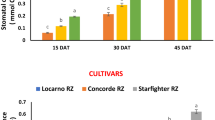Abstract
The multipurpose tree Faidherbia albida, which is highly recommended for evergreen agriculture, lacks much more recent ecophysiological data. Due to climate change global temperatures are rising; droughts are more common as water is becoming less and less available. How will plants, especially F. albida respond to these changes? We, therefore, set out to understand the effects of varied light and moisture levels. One hundred and thirty-five (135) 120-day-old seedlings were exposed to different light (75, 43 and 16% of full sunlight) and moisture [100, 50 and 25% of field capacity (32.6 ml/100 g of soil)] levels for 12 weeks. There were significant light and water main effects on most growth parameters, below ground biomass (BGB), above ground biomass (AGB), root:shoot ratio (RSR), concentration of chlorophyll b and quantum efficiency of photosystem II of the seedlings. Significant interactions were only recorded on the number of leaves (NL), stem diameter (SD), below ground biomass (BGB) and above ground biomass (AGB). The best water use efficiency, WUE (2661 ml/g), was recorded in the high-light medium-moisture (HLMM) treatment. Our results show that F. albida is affected differently by the different light and moisture levels. There also exists high stress tolerance level. We, therefore, highly recommend it for incorporation into most farming systems even when shading of seedlings constitutes a major intercropping problem.


Similar content being viewed by others
References
Adabavazeh F, Razavizadeh R (2015) Comparison of drought tolerance of four varieties of Brassica napus under in vitro culture. Adv Environ Biol 9(2):135–142
Baker TR, Swaine MD, Burslem DFRP (2003) Variation in tropical forest growth rates: combined effects of functional group composition and resource availability. Perspect Plant Ecol Evol Syst 6(1/2):21–36
Cable S, Cheek M (1998) The plants of Mount Cameroon: a conservation checklist. R Bot Gardens, Kew
Chuyong GB, Acidri T (2015) Combining pre-sowing treatments in Faidherbia albida (Delile) A. Chev. does not imply better germination success. Int J Plant Soil Sci 8(1):1–6
Craven D, Gulamhusseina S, Berlyna GP (2010) Physiological and anatomical responses of Acacia koa (Gray) seedlings to varying light and drought conditions. Environ Exp Bot 69:205–213
Egbe EA, Forkwa EY, Mokake ES, Ngane EB (2013) Early growth, biomass allocation and water use efficiency of three species of tropical tree seedlings at four moisture level. Glob Adv Res J Agric Sci 2(2):047–058
Egbe EA, Forkwa EY, Enow EA (2014) Evaluation of seedlings of three woody species under four soil moisture capacities. Br J Appl Sci Technol 4(24):3455–3472
Engelbrecht BMJ, Krursar TA, Tyree MT (2005) Drought effects of seedlings in a tropical moist forest. Trees 19:312–321
Fracheboud Y (2006) Using chlorophyll fluorescence to study photosynthesis. Institute of Plant Sciences ETH, Universitatstrass, CH-8092 Zurich
Garrity DP, Akinnifesi FK, Ajayi OC, Weldesemayat SG, Mowo JG, Kalinganire A, Larwanou M, Bayala J (2010) Evergreen agriculture: a robust approach to sustainable food security in Africa. Food Secur 2:197–214
Guo X, Zhang X, Huang Z (2010) Drought tolerance in three hybrid poplar clones submitted to different watering regimes. J Plant Ecol 3(2):79–87
Guo X, Guo W, Luo Y, Tan X, Du N, Wang R (2013) Morphological and biomass characteristic acclimation of trident maple (Acer buergerianum Miq.) in response to light and water. Acta Physiol Plant 35:1149–1159
Haris RW (1992) Root:shoot ratios. J Arboric 18(1):39–42
Jones HG (2004) What is water use efficiency? In: Bacon MA (ed) Water use efficiency in plant biology. Blackwell Publishing, UK, pp 27–41
Lichtenthaler HK, Buschmann C (2001) Chlorophylls and carotenoids: measurement and characterization by UV–VIS spectroscopy. Curr Protoc Food Anal Chem 3:1–8
Liu X, Fan Y, Long J, Wei R, Kjelgren R, Gong C, Zhao J (2013) Effects of soil water and nitrogen availability on photosynthesis and water use efficiency of Robinia pseudoacacia seedlings. J Environ Sci 25(3):585–595
Mokgolodi NC, Setshogo MP, Ling-ling S, Yu-jin L, Chao M (2011) Achieving food security and nutritional security through agroforestry: a case of Faidherbia albida in sub-Saharan Africa. For Study China 13(2):123–131
Muthomi J, Musyimi DM (2009) Growth response of African nightshades (Solanum scabrum Mill) seedlings to water deficit. ARPN Agric Biol Sci 4(5):24–31
Naylor RL (2008) Managing food production systems for resilience. In: Chapin FS, Kofinas GP, Folke C (eds) Principles of natural resource stewardship: resilience-based management in a changing world. Springer, New York (in press)
Ndam N, Fraser R (1998) Assessment of Natural Regeneration of Prunus africana (Hook. f.) Kalkman on Mount Cameroon, In: A strategy for the conservation of Prunus africana on Mount Cameroon. Technical papers and workshop proceedings, Limbe, Cameroon, 21–22 Feb 1996
Sahn DE, Younger S (2009) Living standards in Africa. Initiative for Policy Dialogue Working Paper Series, Columbia University, p 1
United Nations UN (2014) Concise Report on the World Population Situation in 2014. Department of Economic and Social Affairs Population Division. ST/ESA/SER.A/354
Wickens G (1969) A study of Acacia albida (Mimosoideae). Kew Bull 23:181–202
Acknowledgements
The authors acknowledge the Erasmus Mundus Intra ACP Strengthening African Higher Education through Academic Mobility (STREAM) project for the study scholarship at the University of Buea, Cameroon and Research Modernisation Allowance from the Ministry of Higher Education (MINESUP) Cameroon.
Author information
Authors and Affiliations
Corresponding author
Ethics declarations
Funding
This research did not receive any specific grant from funding agencies in the public, commercial, or not-for-profit sectors.
Conflict of interest
The authors declare that they have no conflict of interest.
Additional information
Communicated by T. K. Mondal.
Rights and permissions
About this article
Cite this article
Chuyong, G.B., Acidri, T. Light and moisture levels affect growth and physiological parameters differently in Faidherbia albida (Delile) A. Chev. seedlings. Acta Physiol Plant 39, 117 (2017). https://doi.org/10.1007/s11738-017-2410-0
Received:
Revised:
Accepted:
Published:
DOI: https://doi.org/10.1007/s11738-017-2410-0




